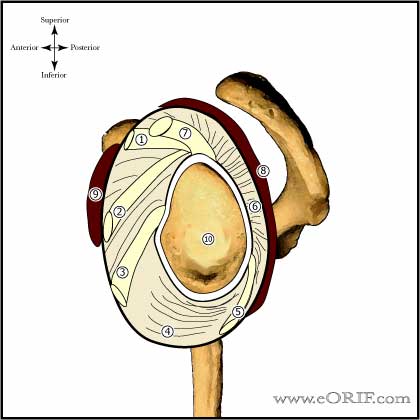|



|
synonyms: posterior labral repair, capsular plication
Arthroscopic Posterior Stabilization Indications
Arthroscopic Posterior Stabilization Contraindications
- Voluntary, habitual instability due to psychological problems.
- Excessive glenoid retroversion (consider glenoid opening wedge osteotomy)
- Posterior glenoid bone loss (uncommon)
- >25% Humeral head loss (reverse Hills-Sachs lesion)
- Connective tissue disorders: Ehlers-Danlos, Marfan syndrome)
Arthroscopic Posterior Stabilization Alternatives
Arthroscopic Posterior Stabilization Pre-op Planning / Special Considerations
- Ensure there is not a glenoid or humeral head lesion requiring bone graft or OATS.
- Ensure adequate suture anchors (3.0mm or smaller anchors) and suture passing device (Spectrumor similar) are available.
- Ensure any suture anchors are placed at the appropriate depth to avoid iatrogenic accelerated osteoarthritis, i.e. high anchors destory the humeral head articular cartilage.
- Shoulder Arthroscopy case card.
Arthroscopic Posterior Stabilization Technique
- Sign operative site
- Pre-operative antibiotics, +/- regional block
- General endotracheal anesthesia
- Lateral position. All bony prominences well padded.
- Examination under anesthesia.
- Perform shoulder arthroscopy. Evaluate for reverse Hill-Sachs, posterior labral avulsion, reverse HAGL, Kim lesion, capsular tears, SLAP lesions, widened rotator interval, anterior labral tear.
- Generally use additional posterior portal inferior and lateral to the working posterior portal. Posterior work is done while viewing from the anterior portal.
- If posterior labrum is avulsed: Release posterior labroligamentous structures from the posterior glenoid and freshen the glenoid neck with a bur. Place anchors as indicated, pass sutures and tie. Consider added posterior capsular plication.
- If posterior labrum is intact: Perform posterior capsular plication. Roughen capsule with abrader or rasp. Use curved suture hook (left hook for right shoulder) to plicate capsule from 6 o'clock to 9 or 10 o'clock position.\
- rHAGL lesions: are repaired with anchors placed into the humeral head.
Arthroscopic Posterior Stabilization Complications
- Recurrent instability
- Inability to return to competitive sports
- Persistent pain
- Infection
- Stiffness
- CRPS
- Nerve injury: Axillary nerve, suprascapular nerve.
- Fluid Extravasation:
- Chondrolysis: though to be related to heat from electo cautery or radiofrequency probes used during capsular release or capsular shrinkage.
- Hematoma
- Chondral Injury / arthritis
Arthroscopic Posterior Stabilization Follow-up care
- Post-op: Place in shoulder immobilizer in slight abduction, slight extension and slight external rotation. Avoid flexion and internal rotation to protect repair. Perform elbow, wrist, hand ROM/strengthening,
- 7-10 Days: Wound check, continue immobilization,
- 6 Weeks: Discontinue immobilizer; begin cross-body adduction and light progressive resistive exercises / PT.
- 3 Months: Begin sport specific training.
- 4 Months: May return to non-contact sports.
- 6 Months: May return to contact/collision sports.
- Shoulder arthroscopy Rehab Protocol.
Arthroscopic Posterior Stabilization Outcomes
Arthroscopic Posterior Stabilization Review References
|



